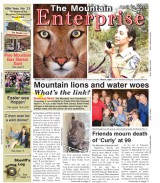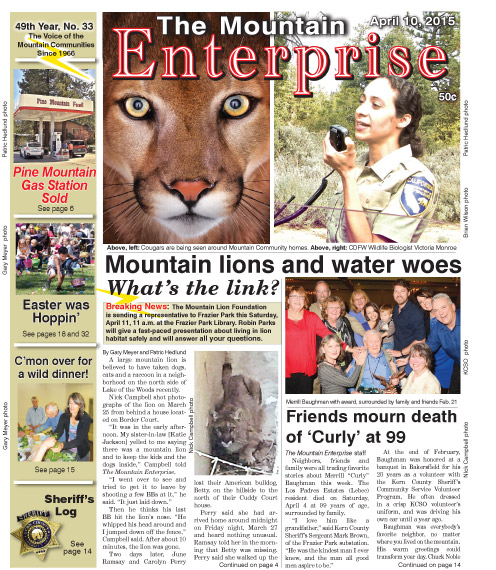FRAZIER PARK, CA (Saturday, April 11 at 2:15 p.m.)—A field representative from the Mountain Lion Foundation gave a two-hour presentation today at Frazier Park Library to 67 people who came to learn about facts, myths and misunderstandings of mountain lions in California. Following the scares in Lake of the Woods and the reported killing of a family dog by a mountain lion, with allegations of four pets taken in the area and questions about the safety of children, the Mountain Lion Foundation sent a representative to Frazier Park today. The foundation gave a free public presentation about living in lion habitat and answered questions from the audience. The event was coordinated by The Mountain Enterprise newspaper with the Frazier Park Library. The gathering was in the community room of the library. Parks said he would like to arrange another visit to the area and present more information.
In January of 2014, Senate Bill 132 (SB-132) became law, establishing protections for mountain lions, which are consistent with the California Wildlife Protection Act of 1990. Below is the text of SB-132:
Senate Bill No. 132
CHAPTER 208
An act to add Section 4801.5 to the Fish and Game Code, relating to mountain lions.
[ Approved by Governor September 06, 2013. Filed with Secretary of State September 06, 2013. ]LEGISLATIVE COUNSEL’S DIGEST
SB 132, Hill. Mountain lions.
Proposition 117, an initiative measure approved by the voters at the June 5, 1990, statewide direct primary election, enacted the California Wildlife Protection Act of 1990. The act establishes that the mountain lion is a specially protected mammal under the laws of this state, and makes it unlawful to take, injure, possess, transport, import, or sell any mountain lion or any part or product thereof. The act authorizes the Department of Fish and Wildlife, or a specified appropriate local agency authorized by the department, to remove or take any mountain lion that is perceived to be an imminent threat to public health or safety or that is perceived by the department to be an imminent threat to the survival of certain sheep species. Under the act, mountain lions that are authorized to be taken are required to be taken by the most effective means available, except a taking by certain designated means is prohibited.
This bill would require nonlethal procedures, as defined, to be used when removing or taking any mountain lion that has not been designated as an imminent threat to public health or safety, as defined. The bill would authorize the department, as the department determines is necessary to protect mountain lions or the public, to authorize qualified individuals, educational institutions, governmental agencies, or nongovernmental organizations to implement nonlethal procedures.
The California Wildlife Protection Act of 1990 prohibits the Legislature from changing the act, with specified exceptions, except by a 4/5 vote of the membership of both houses of the Legislature and then only if consistent with, and in furtherance of, the purposes of the act.
This bill would declare that it is consistent with, and furthers the purposes of, that act.
DIGEST KEY
Vote: four_fifths Appropriation: no Fiscal Committee: yes Local Program: no
BILL TEXT
THE PEOPLE OF THE STATE OF CALIFORNIA DO ENACT AS FOLLOWS:
SECTION 1. Section 4801.5 is added to the Fish and Game Code, to read:
4801.5. (a) Unless authorized in this chapter, nonlethal procedures shall be used when removing or taking any mountain lion that has not been designated as an imminent threat to public health or safety.
(b) For purposes of this chapter, “imminent threat to public health or safety” means a situation where a mountain lion exhibits one or more aggressive behaviors directed toward a person that is not reasonably believed to be due to the presence of responders.
(c) For purposes of this chapter, “nonlethal procedures” means procedures that may include, but are not limited to, capturing, pursuing, anesthetizing, temporarily possessing, temporarily injuring, marking, attaching to or surgically implanting monitoring or recognition devices, providing veterinary care, transporting, hazing, rehabilitating, releasing, or taking no action.
(d) The department may, as the department determines is necessary to protect mountain lions or the public, authorize qualified individuals, educational institutions, governmental agencies, or nongovernmental organizations to implement nonlethal procedures on a mountain lion in accordance with subdivision (a).
SEC. 2. The Legislature finds and declares that the provisions of this act are consistent with, and further the purposes of, the California Wildlife Protection Act of 1990.
This is part of the April 10, 2015 online edition of The Mountain Enterprise.
Have an opinion on this matter? We'd like to hear from you.

![A representative from the Mountain Lion Foundation summarizes the scope of his presentation earlier today at Frazier Park Library. [video frame by Patric Hedlund]](https://mountainenterprise.com/wp-content/uploads/thumbnail-Parks.jpg)

